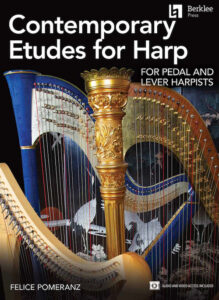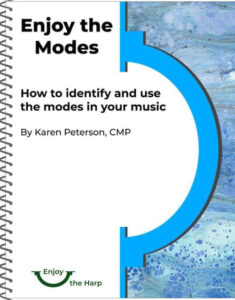
If you plan to make a New Year’s resolution to learn something new or broaden your approach to other genres, there are some new publications that may be of interest.
Most of us have our favorite etude books that we like to use for ourselves or our students. The works of Bochsa, Naderman, Pozzoli, and others have been around for years. Thanks to Felice Pomeranz, we now have a new book of Contemporary Etudes for Harp. Before the internet, we rarely had the luxury of listening to recordings of etudes. Now we can not only listen to audio recordings of them, but we can also watch videos of the various techniques used in the etudes.
This epic new book is published by Berklee Press and distributed by Hal Leonard. When you purchase the book, you can download the accompanying audio and video recordings using an access code in the front of the book.
Some of the truly unique aspects of this collection are that it explores other genres such as jazz, advanced harmonies and improvisation, and can be used or adapted by both pedal and lever harp players.
There are 24 etudes in the book. Many were written by Pomeranz, professor of harp at Berklee College of Music, but there were also 14 other contributors. All proceeds from the book go to the Berklee College Harp Scholarship Fund.
At the beginning of the piece, there is a list of the focus, level, and skills used in the etude. For several of the etudes the focus is harmony-based. Others focus on rhythm and hand independence, modulating, pedal and lever slides, multiple meters, and bass lines, among others. The level of all the etudes is intermediate or higher. There are a wide variety of skills from articulation and arpeggiation of chords to xylophonic and other effects. More than 30 different skills are drilled in these etudes, and you won’t find many of them in other etude books. Some pieces introduce or concentrate on things such as whole tone scales, comping, secondary dominant progressions, playing swing eighth notes, learning pentatonic and blues scales, the contrafact, and even scat singing while playing.
There is a short but thorough explanation of the concepts introduced before each etude. These mini lessons include advice on how to approach learning the piece as well as illustrations when helpful. Pomeranz coaches the player on mastering these concepts. For example, in the second selection, “Classical Style b9 Etude,” she challenges the player to find all the V7(b9) chords and provides an answer key upside down at the bottom of the page. Players are encouraged to avoid writing in pedal or lever changes because learning to keep track of them mentally improves reading skills.
A list of notation symbols used is included in the foreword, and some additional symbols appear in some etudes when the symbol is unique to that piece. Eight videos are included in which Pomeranz demonstrates harmonics in combinations, timpanic effects, thumbnail glisses, the splat, single line finger muffles, xylophonic effect, slap bass, and other muffling techniques. It is helpful to listen to the recording of each piece, and there are two recordings of some etudes when there is something specifically for lever harp. There’s even a recording of just the drum track to the etude “Harp da Funk” so you can play along.
This is a well-organized, comprehensive, and innovative resource for both pedal and lever harpists. This book will keep you busy for a long time!

Another book that is chock-full of information is a new treatise on modes by Karen Peterson. Enjoy the Modes is subtitled “How to identify and use the modes in your music,” and it is self-published by Peterson’s business, Enjoy the Harp. There are 161 pages in this spiral-bound volume. It is intended for anyone who has heard of modes but doesn’t know what to do next.
This book covers the LIMDAP modes: Lydian, Ionian, Mixolydian, Dorian, Aeolian, and Phrygian. Peterson’s approach is relaxed and easy-going. She encourages you to read the book in any order, selecting what you want to know from the table of contents. Some music theory is included toward the back of the book, as she stresses that knowing theory is not a requirement for using the modes.
Peterson was inspired to write this book because so many other books on the subject stay in the key of C, asking you to compare the sound of D Dorian to G Mixolydian. She found it easier to learn the differences when using the same tonal center, so most of the examples in her book are in parallel modes of G.
She shows you how to take advantage of using the same, cookie-cutter hand position for major and minor chords and simply changing your levers or pedals to hear the difference between the various modes on the same strings.
Peterson introduces modes by comparing them to wine, with major-sounding modes being like white wines and minor-sounding modes being the red wines. She uses this color palette of light to dark illustrating the modes throughout the book.
She also created colorful charts to illustrate intervals and whole and half steps.
The book includes lead sheets for more than 25 tunes, and she provides a list of other books on the topic of modes. If this user-friendly approach appeals to you, you will probably enjoy this book. •






